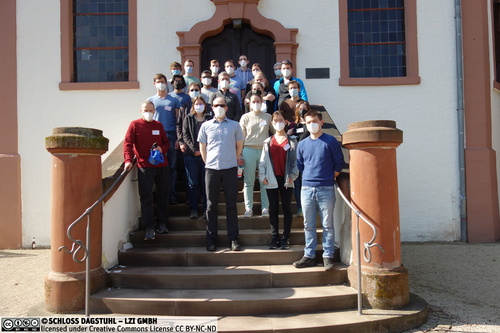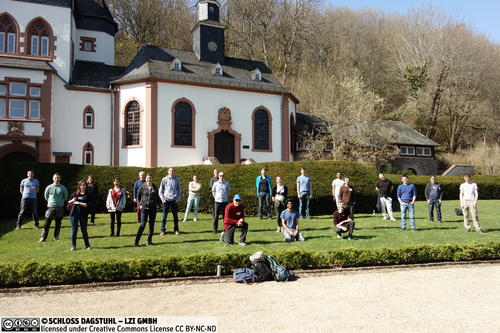Dagstuhl-Seminar 22121
3D Morphable Models and Beyond
( 20. Mar – 25. Mar, 2022 )
Permalink
Organisatoren
- Bernhard Egger (Universität Erlangen-Nürnberg, DE)
- William Smith (University of York, GB)
- Christian Theobalt (MPI für Informatik - Saarbrücken, DE)
- Stefanie Wuhrer (INRIA - Grenoble, FR)
Kontakt
- Michael Gerke (für wissenschaftliche Fragen)
- Simone Schilke (für administrative Fragen)
Sponsoren
Programm
A total of 63 people were invited to the seminar in the first round of invitations. 39 people attended, with 15 of those attending the seminar virtually. Participants came from both academia and industry and at varying stages of their careers. As this seminar took place at the trailing end of the Covid-19 pandemic, it ran in a hybrid format, and for many attendees, Dagstuhl was the first in-person seminar in several years. Due to the fantastic facilities of the Dagstuhl campus, the hybrid format was a great success, enabling accessible and inclusive communication with remote participants. Daily Covid testing for those in-person ensured that everyone remained safe throughout the week. Eighteen presented their work in around 15-30 minute presentations; an abstract for each talk is included in this report.
Alongside traditional presentations, many sessions were left available for activities suggested by the seminar participants. These could involve workshops, discussions, presentations, or any other suggested format. During the week, participants could propose plans for the flexible sessions and the structure of the seminar became fixed as activities and topics for the sessions were provided. Summaries for the results of these flexible sessions are contained in this report. One slot was reserved for a joint group discussion on the ethical concerns of the research we are developing. This resulted in a vivid discussion on the steps we as a community should be taking to encourage the ethical use of the technology we are developing. One of the discussions that received broad support was the design of a cheap, open-source method for collecting camera calibrated illumination environments. This resulted in a Slack channel for the group of interested researchers and the pursuit of an early prototype design. We started the seminar with a short introduction from all participants. Everyone was given one slide to introduce themselves and asked to prepare a question, challenge or goal to discuss during the seminar.
 James Gardner, Bernhard Egger, William Smith, Christian Theobalt, and Stefanie Wuhrer
James Gardner, Bernhard Egger, William Smith, Christian Theobalt, and Stefanie Wuhrer
The Morphable Face Model paper of 1999 was the beginning of what is now a wide research field around the construction, fitting and application of those models. Since then, 3D morphable models have developed into a key concept in the reconstruction and understanding of real-world scenes from images, as well as the controllable synthesis of real-world imagery. The strong growth led to a variety of interpretations and applications and there is still lots of active research in this direction.
Recently, parts of the community shifted towards topics including neural rendering and representation learning which led to new possibilities, including more realistic rendering as well as multi-object models. Whilst those methods are novel and some are more a proof of concept than ready to be used in real-world applications, they have a strong potential since they can be learned from image data and do not rely on handcrafted models or large corpora of scanned 3D data that are hard to capture in practice.
In this Dagstuhl Seminar we aim to bring together researchers from industry and academia that work at the interface of morphable models, neural rendering and implicit representation learning. On the one hand, we will focus on classical methods, namely 3D Morphable Models (3DMMs) based on explicit shape representations and classical computer graphics based rendering pipelines emulating physical light transport. On the other hand, we will explore synergies to novel learned 3D generative models as well as novel neural rendering algorithms that replace or complement established computer graphics concepts with machine learned concepts. The seminar will therefore offer a unique platform to deeply and systematically explore the methodological synergies between these originally separately researched directions in graphics, vision, and machine learning. The seminar is meant to initiate cross-fertilization between those research areas to allow combining their benefits with the goal of building better models of the world.
This seminar aims to capture the key ideas and persons in the field to enable a coordinated approach to current limitations and open research questions as well as establishing stronger collaborations in this research area.
 Bernhard Egger, William Smith, Christian Theobalt, and Stefanie Wuhrer
Bernhard Egger, William Smith, Christian Theobalt, and Stefanie Wuhrer
- Thabo Beeler (Google - Zürich, CH) [dblp]
- Volker Blanz (Universität Siegen, DE) [dblp]
- Timo Bolkart (MPI für Intelligente Systeme - Tübingen, DE) [dblp]
- Dan Casas (Universidad Rey Juan Carlos - Móstoles, ES) [dblp]
- Bernhard Egger (Universität Erlangen-Nürnberg, DE) [dblp]
- Victoria Fernandez Abrevaya (MPI für Intelligente Systeme - Tübingen, DE) [dblp]
- James Gardner (University of York, GB)
- Oshri Halimi (Technion - Haifa, IL)
- Patrik Huber (University of York, GB) [dblp]
- Marilyn Keller (MPI für Intelligente Systeme - Tübingen, DE) [dblp]
- Ron Kimmel (Technion - Haifa, IL) [dblp]
- Adam Kortylewski (MPI für Informatik - Saarbrücken, DE) [dblp]
- Chunlu Li (Universität Basel, CH)
- Ben Mildenhall (Google - London, GB) [dblp]
- Nick Pears (University of York, GB) [dblp]
- Sami Romdhani (IDEMIA, FR) [dblp]
- Vincent Sitzmann (MIT - Cambridge, US) [dblp]
- Ayush Tewari (MIT - Cambridge, US) [dblp]
- Christian Theobalt (MPI für Informatik - Saarbrücken, DE) [dblp]
- Roy Velich (Technion - Haifa, IL)
- Thomas Vetter (Universität Basel, CH) [dblp]
- Vanessa Wirth (Universität Erlangen-Nürnberg, DE)
- Stefanie Wuhrer (INRIA - Grenoble, FR) [dblp]
- Tarun Yenamandra (TU München, DE)
- Michael J. Black (MPI für Intelligente Systeme - Tübingen, DE) [dblp]
- Federica Bogo (Meta Reality Labs Research - Zürich, CH)
- Duygu Ceylan (Adobe Research - London, GB) [dblp]
- Andrew Fitzgibbon (Graphcore - Cambridge, GB) [dblp]
- Tal Hassner (Facebook - Menlo Park, US) [dblp]
- Hao Li (Pinscreen - Los Angeles and UC Berkeley) [dblp]
- Xiaoming Liu (Michigan State University - East Lansing, US) [dblp]
- Arianna Rampini (Sapienza University of Rome, IT) [dblp]
- Emanuele Rodolà (Sapienza University of Rome, IT) [dblp]
- Shunsuke Saito (Reality Labs - Pittsburgh, US) [dblp]
- William Smith (University of York, GB) [dblp]
- Justus Thies (MPI für Intelligente Systeme - Tübingen, DE) [dblp]
- Maximilian Weiherer (Universität Erlangen-Nürnberg, DE)
- Jiajun Wu (Stanford University, US) [dblp]
- Stefanos Zafeiriou (Imperial College London, GB) [dblp]
Verwandte Seminare
Klassifikation
- Computer Vision and Pattern Recognition
- Graphics
- Machine Learning
Schlagworte
- Analysis-by-Synthesis
- Generative Models
- Implicit Representations
- Neural Rendering
- Inverse Rendering




 Creative Commons BY 4.0
Creative Commons BY 4.0
